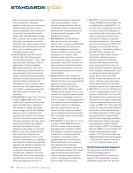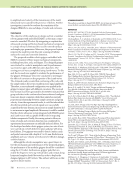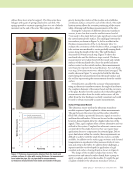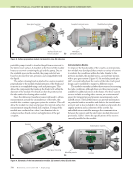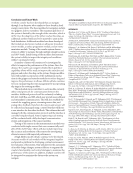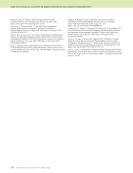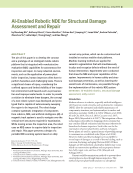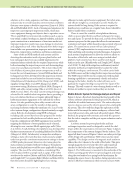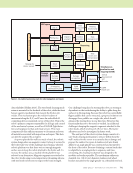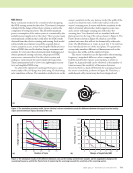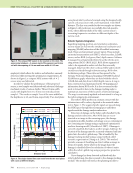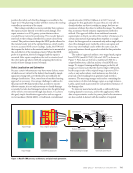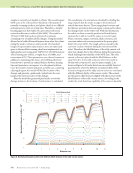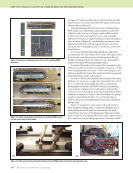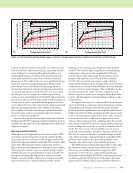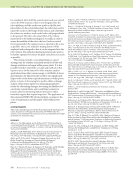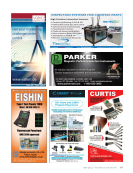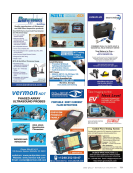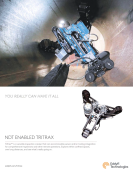730 M A T E R I A L S E V A L U A T I O N • J U L Y 2 0 2 1 contracting their body segments sequentially. Each module holds a linear actuator consisting of a rotating lead screw and nut. The basic design is composed of five modules: two grippers, one at the front and one near the rear of the system two extenders between the grippers and one electronics module. The modules are connected via a flexible cable that has the strength to handle the push/pull loads and is also flexible enough to allow for significant rotation between the modules. Each gripper contains linkage arms that push small pads radially outward and engage the inner pipe wall. The radial symmetry of the design allows for three sets of linkage arms and gripper pads. These linkages are driven by a mechanism attached to the nut of the rotating lead screw. Similarly, the extenders utilize a nut at the center of the module that expands and contracts. Two electric motors on the sides of the module utilize a gearbox to power the lead screw. The selection of actuators was critical to the design of the crawler. The choice of electric linear actuators versus pneu- matic actuators involved the consideration of several factors. Reliance on compressed air throughout the crawler posed a challenge in the tether design management. Additionally, electric motors are much smaller and require thinner wiring than pneumatic motors. It should be noted that there was a clear trade-off between reducing the module’s overall dimen- sions versus simplifying the controls of the system. Pneumatic actuators provide a much simpler method of producing the linear motion. This challenge was addressed in developing the electronics and communication system for the crawler. A module has been incorporated into the system that houses the major elec- tronic components. This includes the embedded microcon- troller, voltage regulator, current sensors, and motor controllers, which are mounted onto printed circuit boards. The electronics module was added to the rear end of the system and controls the movement of each gripper and extender. Figure 2 shows a prototype of the base crawler system with the five modules. Simulation Model The development of the crawler significantly depended on the coil geometry. In an initial geometric analysis, efforts were made to design the system to be capable of navigating through 5 cm radius bends. This led to the to the modules having a maximum diameter of 3.5 cm and a maximum length of 7 cm. To improve the design of the peristaltic crawler and set the framework to evaluate the controls of the system, a high- fidelity model is being developed. Figure 3 shows a detailed schematic of the gripper and extender modules and includes ME TECHNICAL PAPER w robotic inspection of small-diameter superheater pipes Figure 2. Prototype of the base robotic crawler. 7 cm Lead screw Lead nut Spring Stroke Stroke End cap 7 cm 2.58 cm 2.58 cm 2 cm 1 cm 1.5 cm 3.5 cm 3.5 cm 1.5 cm 5.16 cm Lead screw Micro gearmotor Figure 3. Schematic of the primary modules: (a) gripper (b) extender. (a) (b)
J U L Y 2 0 2 1 • M A T E R I A L S E V A L U A T I O N 731 key components and dimensions. The gripper module consists of a total of 31 bodies and uses 14 joints to incorpo- rate the constraints needed to generate the required motion. In addition, 16 constraints are used to implement limitations on the motion. The bodies include two end caps that can be used to mount the flexible connecting cable between the modules, a lead screw, a lead nut, and a helical spring. Addi- tionally, there are nine links connecting the spring and the bottom end caps that support the gripper pad with a revolute joint. This joint provides the constraints so that the pads can contact the internal pipe surface, regardless of the orientation of the linkage. A micro gearmotor is used to rotate the lead screw and expand the linkages that mate the pads with the pipe surface. Similarly, the extender consists of 22 bodies and uses eight joints to generate the motion. However, only one motion constraint is required, which limits the module’s extension distance. Two micro gearmotors are used in the extender to provide the necessary torque on the lead screw that extends to the top of the module. The stroke length for each module is approximately 2.58 cm, resulting in 5.16 cm of displacement for each cycle of the crawler. Motion Analysis To generate peristaltic motion of the crawler, the gripper in the rear extends and fixes its position within the tube while the other modules are collapsed. With the rear gripper position fixed, the two extenders simultaneously extend, moving the front gripper forward 5.16 cm. The front gripper then extends, fixing its position within the tube, and the rear gripper collapses. The two extenders then retract, pulling the rear gripper forward 5.16 cm. The cycle generates 5.16 cm of motion for the crawler and is repeated continuously until the crawler reaches its destination. In addition, a simplified force analysis of a single gripper and extender in a static state was conducted. The gripper must be capable of generating a friction force greater than the drag force generated from the tether. If the friction force is lower than the drag force, the gripper will slip backward. Similarly, when the extender is retracting, it must be capable of overcoming the tether load or there would be no motion generated. A simulation of the gripper and extender was created using a motion simulation package. The analysis included extending one gripper that was resting on the bottom of a 5 cm tube. A motor drives the lead screw, which extends the gripper arms until the three pads reach the tube’s inner wall, as shown in Figure 4. The normal force produced from the simulation is also shown in Figure 4. A peak force of approximately 60 N was obtained for one gripper. The result also shows smaller peaks in the normal force as the linkage arms extend. These peaks were due to the weight of the gripper on the lower arm. The friction force generated by the gripper is dependent on the normal force and the coefficient of friction between the pad and tube wall. For this analysis, a coefficient of friction of 0.6 was used for the interface between the rubber pad and steel tube surface. This was experimentally determined in accor- dance with ASTM D1894 (2014) and is in agreement with standard values provided in the literature. This provides a maximum static friction force of 36 N per pad. With the three pads, this results in a simulated force of 108 N. Additional data from the simulation with the gripper shows the axial motion of the lead screw, the radial displace- ment of the arm linkage, and the radial displacement of the gripper pad (Figure 5). The simulation was conducted from the closed position to the extended position. As the nut is moved forward, the angle of the linkages changes and moves the gripper pad toward the inner pipe. A simulation was also conducted of the extender module. Similar to the gripper, a motor drives a lead screw, causing the lead nut to extend toward the module’s end cap. The maximum extension of the module is 2.58 cm. Both the front and back gripper modules will be connected to the extender modules via short flexible wires. 0 0 0.2 0.4 0.6 0.8 1 Time (s) 10 20 30 40 50 60 X Y Z X Y Z Figure 4. Motion analysis of the gripper: (a) gripper closed (b) gripper extended (c) plot of gripper pad contact force. (a) (b) (c) Gripper pad reaction force (N)
ASNT grants non-exclusive, non-transferable license of this material to . All rights reserved. © ASNT 2025. To report unauthorized use, contact: customersupport@asnt.org



























































